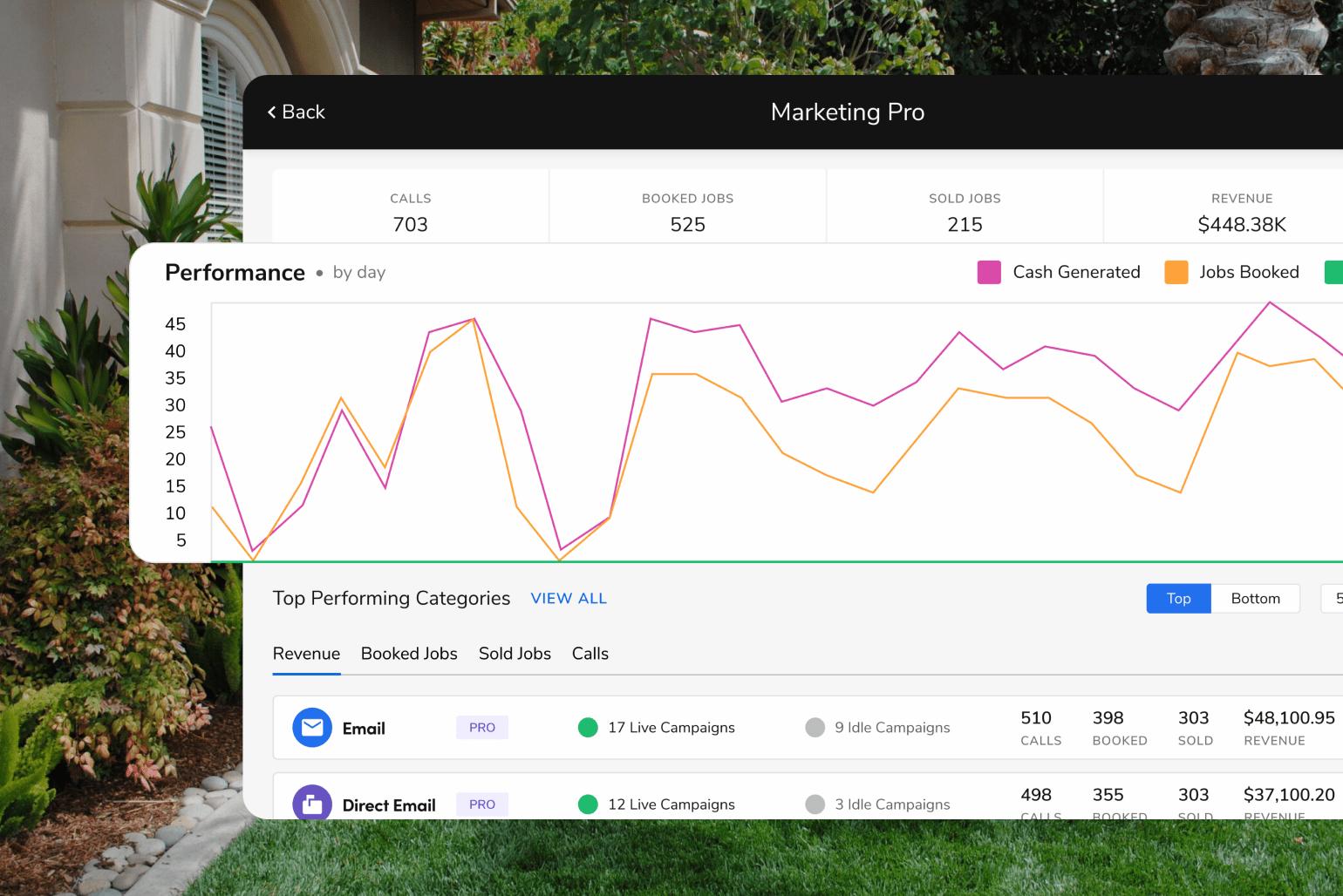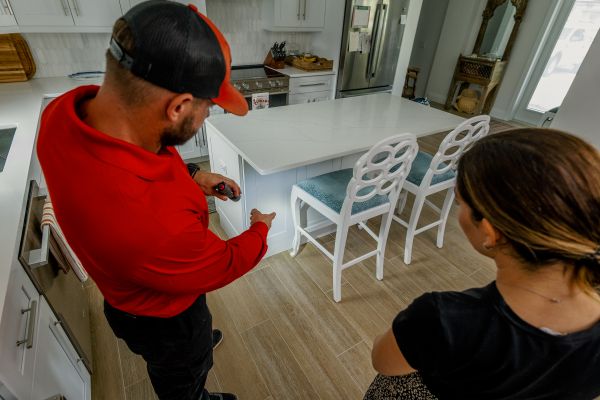Setting Sales Goals for Pest Control Business (Enhance Revenue & Growth)

Sales goals are specific targets a business sets to drive revenue and growth. For business owners, these are often customer acquisition, more pest removal jobs, or recurring services.
Achieving these sales goals requires a strategic approach and consistent effort from every salesperson on your team.
This guide will teach you seven practical tips to help your business hit its sales goals. From creating an action plan to upselling and using data-driven insights, these will help you stay focused, improve performance, and grow your customer base.
1. Create a Sales Plan
An action plan is a document that outlines the specific objectives your pest control business wants to achieve and the steps to get there.
Think of your sales plan as a roadmap for your sales training. Use it to ensure everyone is on track to hit the company’s sales goals and understand the sales pitch you want to communicate to potential clients.
A good action plan includes sales forecasting, goal setting, market research, and new customer engagement.
Sales Forecasting and Goal Setting The first step in creating an action plan is to set clear, achievable goals.
Break these goals into monthly or quarterly targets, focusing on key metrics like revenue, new customer acquisition, or the number of jobs. Forecast your sales goals based on past performance and market demand to set realistic expectations.
Market and Customer Research Know your target market.
Do a local search of your target audience, such as homeowners or commercial property managers, and create buyer personas. Your marketing efforts should include researching their pest problems and how your services can solve them. This research will help you craft messaging that speaks to your potential customers and refine your pest control sales approach.
Prospecting and Partnerships Your action plan should also outline how you will find and engage new customers. Prospecting, whether through social media, digital marketing, cold calling, door-to-door sales, partnerships with local businesses, or a referral program, is critical to growing your customer base.
Having an action plan can help your pest control business set a course for sales success and long-term growth.
2. Create Upselling Opportunities
Upselling is a great way for pest control businesses to increase revenue and add value to customers.
Once you’ve helped a customer with a specific pest problem, like an ant or rodent issue, offer additional services that address other potential problems. This will increase your revenue and make your business the go-to service provider for future pest control services.
Expand Your Service Offerings Start by offering more than essential pest control services. Add specialized services like bee and hornet removal, mosquito and tick control, or eco-friendly exterminator methods. If a customer has a recurring pest problem, suggest an annual pest prevention plan. This will help you capture more value from each customer interaction.
Tailored Upselling Based on Needs Field technicians can take advantage of opportunities by observing other issues during their visits. For example, while addressing a termite problem, they might see early signs of other pests in the home. With the FieldRoutes Mobile App, technicians can offer on-the-spot upselling recommendations to customers based on their current needs and provide relevant information instantly.
Use Personalized Marketing Automated marketing tools like FieldRoutes pest control software can be used to send personalized messages offering additional services. For example, after completing a termite job, send a follow-up email offering tick control for their yard and a follow-up phone call afterward. This type of automated marketing will encourage repeat business and keep your company in mind for future pest control needs.
By optimizing your upselling, you can increase customer satisfaction and your business’s profitability.
3. Set S.M.A.R.T. Goals
S.M.A.R.T. goals are a strategic framework for setting Specific, Measurable, Attainable, Relevant, and Time-bound objectives. Breaking down these goals into actionable steps will help your pest control business achieve targeted and realistic goals.
By setting clear goals, your sales team will implement your marketing plan to drive growth.
Specific: Define clear and concise goals. Instead of increasing pest control sales, set a goal [for example] to add 15% new customers in the next quarter.
Measurable: Attach measurable metrics to track progress. Use numbers like leads generated, conversion rates, or percentage of pest management services sold.
Attainable: Make realistic goals based on your team’s capabilities and historical data. If your sales reps have been increasing sales by 5% each quarter, a 7% increase is challenging but achievable.
Relevant: The goal should align with your overall business objectives. If expanding your local pest control services is a priority, focus on goals that drive growth in those areas.
Time-bound: Assign deadlines to create urgency and action. For example, add 15% of the new pest control business by the end of Q2, so your team has a clear timeline.
Using the S.M.A.R.T method gives your sales team a path to meet and exceed their targets. This framework holds them accountable and ensures everyone works towards the same company goals.
4. Complete More Jobs Per Day
You must give pest control technicians the right tools, training, and technology to help them complete more daily jobs.
This isn’t about pushing them harder but about making their work more efficient and streamlined.
By using the FieldRoutes Mobile App, technicians can access everything they need, from customer details to route information, in real time to work efficiently and without delay.
More Efficiency: The FieldRoutes Mobile App allows technicians to view job details and customer history and even capture digital signatures from their mobile devices. This reduces paperwork and ensures technicians are fully prepared for each job and more productive.
Efficient Routes: Using FieldRoutes Field Service Routing, businesses can create optimized routes for their technicians so they travel less between jobs. This feature reduces travel time and maximizes the number of appointments a technician can make daily.
Reduced Costs: This technology improves job completion rates and reduces operational costs. By reducing travel time and increasing efficiency, pest control businesses save on fuel and vehicle wear while doing more jobs in the same amount of time.
By providing these tools, technicians are not overworked but empowered to do the job more effectively, increasing customer satisfaction and revenue for the business.
By focusing on efficiency, you can attract more customers per day without sacrificing service quality.
5. Offer Recurring Service Options
Pests infestations are a recurring problem all year round.
Ants, mice, mosquitoes, and other critters show up seasonally.
To address this ongoing issue, offering recurring service options is a win-win for both customers and pest control companies. By offering subscription-based services, you can help customers remain pest-free all year round, taking advantage of seasonal pest infestations.
Consistent Services: Monthly, quarterly, or seasonal visits prevent pests from returning. For example, FieldRoutes can automate scheduling for these recurring services so your technicians deliver the correct treatment at the right time without missing any appointments.
Steady Revenue: Recurring services mean a steady stream of income. This is especially valuable for business clients like restaurants and grocery stores, which are always vulnerable to pests and need ongoing protection.
Customer Convenience: With a subscription service, customers don’t have to remember to book appointments. Regular in-person visits keep pests at bay and increase customer loyalty and long-term satisfaction.
They also ensure that your companies, from established businesses to small ones, have a steady recurring revenue stream so you can grow and plan for the future.
6. Examine Your Data
Analyzing specific data helps identify growth opportunities and adjust marketing and sales strategies effectively to meet sales targets.
Connection Ratio: This metric measures how many first interactions turn into conversions. By increasing this ratio, your pest control sales team can focus on higher-quality prospects and reduce the need for multiple calls or visits.
Initial Meeting Conversion: Track the percentage of first meetings that become follow-up appointments. A higher conversion rate means your sales reps engage with the right prospects, reducing the need for more prospecting.
Sales Cycle Length: Measure how long it takes to close a deal. Shorter sales cycles mean you have a better chance of closing deals, as pest control services are time-sensitive.
Closing Ratio: This tracks how many first meetings turn into actual customers. By monitoring this number, your sales team can focus on high-probability leads.
By reviewing and acting on these data-driven metrics, your team will close more deals and expand your market share.
7. Document the Sales Process of Your Pest Control Business
Documenting your pest control sales process is key to ensuring consistency across your team and the following best practices. When the sales process only exists in the minds of your sales reps, performance can be inconsistent. A documented process keeps everyone on the same page and working towards the same goals.
Create Sales Plays: Develop a series of repeatable steps or “sales plays” for different sales cycle stages. These could be scripts for prospecting, setting up meetings, handling objections, and following up. Sales plays to ensure that everyone on the team knows how to respond to different situations with customers.
Define Customer Buying Stages: Identify the key stages of your pest control business's buyer journey. This will help your sales reps understand where prospects are in decision-making and how to engage with them.
Provide Sales Content: Ensure your team can access suitable marketing materials, such as presentations or brochures (complete with contact information like phone number and email address), to share with customers at different stages of their buying journey. For example, customers reading testimonials are a great way to close a sale if they have doubts. This content should align with your overall pest control marketing strategies.
Use CRM Software: By integrating your documented sales process with a CRM system, you can track customer interactions, manage leads, and measure progress. The system also organizes and makes data accessible for future reference.
By documenting your sales process, your team will be more efficient, close more deals, and approach new business consistently.
Improve Revenue with Cutting-Edge Software
Growing revenue in your pest control business is easier with the right tools. FieldRoutes has software solutions to streamline your sales process, increase efficiency, and grow revenue.
Ensure your cutting-edge software has the following to support your sales team:
Automated Follow-Ups: Stay in front of prospects with automated follow-ups. No lead will fall through the cracks, and your team will convert more inquiries into sales. Missed leads equate to missed sales.
CRM Integration: FieldRoutes CRM software keeps all customer information in one place so your sales reps can track leads and follow up at the right time. This results in fewer missed opportunities and more closed deals.
Efficient Routing: FieldRoutes route optimization tools allow your technicians to complete more jobs per day by reducing travel time. More productivity and lower costs mean more reinvestment in additional sales training, which helps grow your sales further.
Less time spent on admin and more time serving homeowners and businesses will lead to more revenue growth.
Please request a free demo today to see how our software can help boost your sales process, drive revenue, and streamline your overall business operations.





